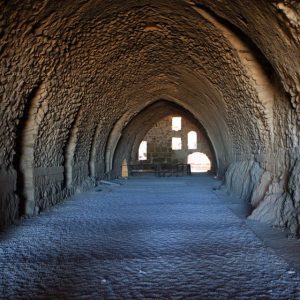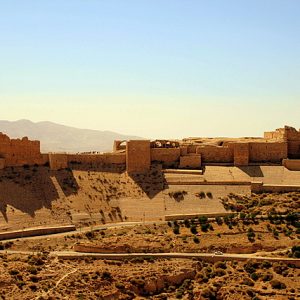Karak City
The magnificent Crusader fortress of Kerak – Crak des Moabites, or Le Pierre du Desert to Crusaders – soars above its valleys and hills like a great ship riding waves of rock.
Kerak’s origins go back long before the Crusaders; the earliest remains are Iron Age, shortly after the Exodus, when this was a part of Moab. It was known as Kir-haraseth, Kir-heres, or Kir, and its doom was prophesied by Isaiah (16:7) who mentions its ‘raisin-cakes’, presumably a local specialty. Then it falls out of history until the Byzantine period, when it was important enough to have an archbishop.
It was the Crusaders who made Kerak (biblical Charach Mouba) famous. The fortress, located 124 km south of Amman, was built in 1142 by Payen le Bouteiller, lord of Montreal and of the province of Oultre Jourdain, on the remains of earlier citadels, which date back to Nabataean times. He made Kerak the new capital of the province, for it was ideally situated on the King’s Highway, where it could control all traffic from north and south.
There were -as there are today- two parts of Kerak: the citadel and its fortress which are separated from the town by a deep dry moat. The fortress is typically Crusader, with lit stone-vaulted rooms and corridors leading into each other through heavy arches and doorways. The best preserved are underground, and to be reached through a massive door.
The castle itself, as an example of the Crusaders’ architectural military genius, is more imposing than beautiful. Each stronghold was built to be a day’s journey from its neighbor. At night, a beacon was lit at each castle to signal to Jerusalem that it was safe.
Among these ruins, are a well-preserved school and an adjoining mosque. All the inhabitants of the town could gather for protection within the citadel in times of danger.
It was not until the end of 1188, after a siege of more than a year that Kerak finally surrendered to the Muslims. Then in 1263 the Mamluk Sultan Baybars took Kerak.
Under Ottomans, it was ruled by local families until 1840, when Ibrahim Pasha, son of Mohammad Ali of Egypt took it, greatly damaging its defenses.
After World War I, Kerak was a British administrative center until Emirate of Transjordan was established in 1921. It remains the center of a large district.
Kerak is still a largely Christian town, and many of today’s Christian families trace their origins back to the Byzantines.


